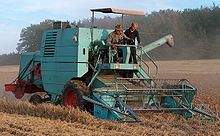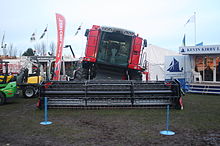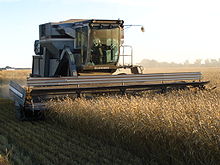- Combine harvester
-
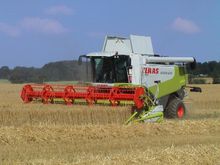 Harvesting oats in a Claas Lexion 570 combine with enclosed, air-conditioned cab with rotary thresher and laser-guided hydraulic steering
Harvesting oats in a Claas Lexion 570 combine with enclosed, air-conditioned cab with rotary thresher and laser-guided hydraulic steering
 Old Style Harvester found in the Henty, Australia region
Old Style Harvester found in the Henty, Australia region
 Case IH Axial-Flow combine
Case IH Axial-Flow combine
The combine harvester, or simply combine, is a machine that harvests grain crops. The name derives from the fact that it combines three separate operations, reaping, threshing, and winnowing, into a single process. Among the crops harvested with a combine are wheat, oats, rye, barley, corn (maize), soybeans and flax (linseed). The waste straw left behind on the field is the remaining dried stems and leaves of the crop with limited nutrients which is either chopped and spread on the field or baled for feed and bedding for livestock.
Contents
History
The combine was invented in the United States by Hiram Moore in 1834, and early versions were pulled by horse or mule teams.[1] In 1835, Moore built a full-scale version and by 1839, over 50 acres of crops were harvested.[2] By 1860, combine harvesters with a cutting width of several metres were used on American farms.[3] In 1882, the Australian Hugh Victor McKay had a similar idea and developed the first commercial combine harvester in 1885, the Sunshine Harvester.[4]
Combines, some of them quite large, were drawn by mule or horse teams and used a bullwheel to provide power. Later, steam power was used, and George Stockton Berry integrated the combine with a steam engine using straw to heat the boiler.[5]Tractor-drawn, PTO-powered combines were then used for a time. These combines used a shaker to separate the grain from the chaff and straw-walkers (grates with small teeth on an eccentric shaft) to eject the straw while retaining the grain. Tractor drawn combines evolved to have separate gas or diesel engines to power the grain separation.
In 1911, the Holt Manufacturing Company of California produced a self-propelled harvester.[6] In Australia in 1923, the patented Sunshine Auto Header was one of the first center-feeding self-propelled harvesters.[7] In 1923 in Kansas, the Curtis brothers and their Gleaner Manufacturing Company patented a self-propelled harvester which included several other modern improvements in grain handling.[8] Both the Gleaner and the Sunshine used Fordson engines. In 1929 Alfredo Rotania of Argentina patented a self-propelled harvester.[9] In 1937, the Australian-born Thomas Carroll, working for Massey-Harris in Canada, perfected a self-propelled model and in 1940 a lighter-weight model began to be marketed widely by the company.[10] In 1952 Claeys launched the first self- propelled combine harvester in Europe;[11] in 1953, the European manufacturer CLAAS developed a self-propelled combine harvester named 'Herkules', it could harvest up to 5 tons of wheat a day.[12] This newer kind of combine is still in use and is powered by diesel or gasoline engines. Until the self-cleaning rotary screen was invented in the mid-1960s combine engines suffered from overheating as the chaff spewed out when harvesting small grains would clog radiators, blocking the airflow needed for cooling.
A significant advance in the design of combines was the rotary design. The grain is initially stripped from the stalk by passing along a helical rotor instead of passing between rasp bars on the outside of a cylinder and a concave. Rotary combines were first introduced by Sperry-New Holland in 1975.[13]
In about the 1980s on-board electronics were introduced to measure threshing efficiency. This new instrumentation allowed operators to get better grain yields by optimizing ground speed and other operating parameters.
Combine heads
Combines are equipped with removable heads that are designed for particular crops. The standard header, sometimes called a grain platform, is equipped with a reciprocating knife cutter bar, and features a revolving reel with metal or plastic teeth to cause the cut crop to fall into the auger once it is cut. A variation of the platform, a "flex" platform is similar but has a cutter bar that can flex over contours and ridges to cut soybeans that have pods close to the ground. A flex head can cut soybeans as well as cereal crops, while a rigid platform is generally used only in cereal grains.
Some wheat headers, called "draper" headers, use a fabric or rubber apron instead of a cross auger. Draper headers allow faster feeding than cross augers, leading to higher throughputs due to lower power requirements. On many farms, platform headers are used to cut wheat, instead of separate wheat headers, so as to reduce overall costs.
Dummy heads or pick-up headers feature spring-tined pickups, usually attached to a heavy rubber belt. They are used for crops that have already been cut and placed in windrows or swaths. This is particularly useful in northern climates such as western Canada where swathing kills weeds resulting in a faster dry down.
While a grain platform can be used for corn, a specialized corn head is ordinarily used instead. The corn head is equipped with snap rolls that strip the stalk and leaf away from the ear, so that only the ear (and husk) enter the throat. This improves efficiency dramatically since so much less material must go through the cylinder. The corn head can be recognized by the presence of points between each row.
Occasionally rowcrop heads are seen that function like a grain platform, but have points between rows like a corn head. These are used to reduce the amount of weed seed picked up when harvesting small grains.
Self propelled Gleaner combines could be fitted with special tracks instead of tires or tires with tread measuring almost 10in deep to assist in harvesting rice. Some combines, particularly pull type, have tires with a diamond tread which prevents sinking in mud. These tracks can fit other combines by having adapter plates made.
Conventional combine
The cut crop is carried up the feeder throat (commonly called the "feederhouse") by a chain and flight elevator, then fed into the threshing mechanism of the combine, consisting of a rotating threshing drum (commonly called the "cylinder"), to which grooved steel bars (rasp bars) are bolted. The rasp bars thresh or separate the grains and chaff from the straw through the action of the cylinder against the concave, a shaped "half drum", also fitted with steel bars and a meshed grill, through which grain, chaff and smaller debris may fall, whereas the straw, being too long, is carried through onto the straw walkers. This action is also allowed due to the fact that the grain is heavier than the straw, which causes it to fall rather than "float" across from the cylinder/concave to the walkers. The drum speed is variably adjustable on most machines, whilst the distance between the drum and concave is finely adjustable fore, aft and together, to achieve optimum separation and output. Manually engaged disawning plates are usually fitted to the concave. These provide extra friction to remove the awns from barley crops. After the primary separation at the cylinder, the clean grain falls through the concave and to the shoe, which contains the chaffer and sieves. The shoe is common to both conventional combines and rotary combines.
Hillside leveling
 Palouse hills
Palouse hills
In the Palouse region of the Pacific Northwest of the United States the combine is retrofitted with a hydraulic hillside leveling system. This allows the combine to harvest the steep but fertile soil in the region. Hillsides can be as steep as a 50% slope. Gleaner, IH and Case IH, John Deere, and others all have made combines with this hillside leveling system, and local machine shops have fabricated them as an aftermarket add-on.
The first leveling technology was developed by Holt Co., a California firm, in 1891.[14] Modern leveling came into being with the invention and patent of a level sensitive mercury switch system invented by Raymond Alvah Hanson in 1946.[15] Raymond's son, Raymond, Jr., produced leveling systems exclusively for John Deere combines until 1995 as R. A. Hanson Company, Inc. In 1995, his son, Richard, purchased the company from his father and renamed it RAHCO International, Inc. In April, 2007, the company was renamed The Factory Company International, Inc.[16] Production continues to this day.
Hillside leveling has several advantages. Primary among them is an increased threshing efficiency on hillsides. Without leveling, grain and chaff slide to one side of separator and come through the machine in a large ball rather than being separated, dumping large amounts of grain on the ground. By keeping the machinery level, the straw-walker is able to operate more efficiently, making for more efficient threshing. IH produced the 453 combine which leveled both side-to-side and front-to-back, enabling efficient threshing whether on a hillsides or climbing a hill head on.
Secondarily, leveling changes a combine's center of gravity relative to the hill and allows the combine to harvest along the contour of a hill without tipping, a very real danger on the steeper slopes of the region; it is not uncommon for combines to roll on extremely steep hills.
Newer leveling systems do not have as much tilt as the older ones. A John Deere 9600 combine equipped with a Rahco hillside conversion kit will level over to 44%, while the newer STS combines will only go to 35%. These modern combines use the rotary grain separator which makes leveling less critical. Most combines on the Palouse have dual drive wheels on each side to stabilize them.
Sidehill leveling system in Europe was developed by Italian combines' manifacturer Laverda that still today produces those systems as a leader.
Sidehill leveling
Sidehill combines are very similar to hillside combines in that they level the combine to the ground so that the threshing can be efficiently conducted; however, they have some very distinct differences. Modern hillside combines level around 35% on average, older machines were closer to 50%. Sidehill combines only level to 18%. They are sparsely used in the Palouse region. Rather, they are used on the gentle rolling slopes of the mid-west. Sidehill combines are much more mass produced than their hillside counterparts. The height of a sidehill machine is the same height as a level-land combine. Hillside combines have added steel that sets them up approximately 2–5 feet higher than a level-land combine.
Maintaining threshing speed
Allis-Chalmers GLEANER L2
Another technology that is sometimes used on combines is a continuously variable transmission. This allows the ground speed of the machine to be varied while maintaining a constant engine and threshing speed. It is desirable to keep the threshing speed constant since the machine will typically have been adjusted to operate best at a certain speed.
Self-propelled combines started with standard manual transmissions that provided one speed based on input rpm. Deficiencies were noted and in the early 1950s combines were equipped with what John Deere called the "Variable Speed Drive". This was simply a variable width sheave controlled by spring and hydraulic pressures. This sheave was attached to the input shaft of the transmission. A standard 4 speed manual transmission was still used in this drive system. The operator would select a gear, typically 3rd. An extra control was provided to the operator to allow him to speed up and slow down the machine within the limits provided by the variable speed drive system. By decreasing the width of the sheave on the input shaft of the transmission, the belt would ride higher in the groove. This slowed the rotating speed on the input shaft of the transmission, thus slowing the ground speed for that gear. A clutch was still provided to allow the operator to stop the machine and change transmission gears.
Later, as hydraulic technology improved, hydrostatic transmissions were introduced by Versatile Mfg for use on swathers but later this technology was applied to combines as well. This drive retained the 4 speed manual transmission as before, but this time used a system of hydraulic pumps and motors to drive the input shaft of the transmission. This system is called a Hydrostatic drive system. The engine turns the hydraulic pump capable of pressures up to 4000 psi. This pressure is then directed to the hydraulic motor that is connected to the input shaft of the transmission. The operator is provided with a lever in the cab that allows for the control of the hydraulic motor's ability to use the energy provided by the pump. By adjusting the swash plate in the motor, the stroke of its pistons are changed. If the swash plate is set to neutral, the pistons do not move in their bores and no rotation is allowed, thus the machine does not move. By moving the lever, the swash plate moves its attached pistons forward, thus allowing them to move within the bore and causing the motor to turn. This provides an infinitely variable speed control from 0 ground speed to what ever the maximum speed is allowed by the gear selection of the transmission. The standard clutch was removed from this drive system as it was no longer needed.
Most if not all modern combines are equipped with hydrostatic drives. These are larger versions of the same system used in consumer and commercial lawn mowers that most are familiar with today. In fact, it was the downsizing of the combine drive system that placed these drive systems into mowers and other machines.
The threshing process
Despite great advances mechanically and in computer control, the basic operation of the combine harvester has remained unchanged almost since it was invented.
First, the header, described above, cuts the crop and feeds it into the threshing cylinder. This consists of a series of horizontal rasp bars fixed across the path of the crop and in the shape of a quarter cylinder. Moving rasp bars or rub bars pull the crop through concaved grates that separate the grain and chaff from the straw. The grain heads fall through the fixed concaves. What happens next is dependent on the type of combine in question. In most modern combines, the grain is transported to the shoe by a set of 2, 3, or 4 (possibly more on the largest machines) augers, set parallel or semi-parallel to the rotor on axial mounted rotors and perpendicular to the cylinder on conventionals (or perpendicular to the cross mounted rotor of Gleaner brand "Natural Flow" combines.) In older Gleaner machines, these augers were not present. These combines are unique in that the cylinder and concave is set inside feederhouse instead of in the machine directly behind the feederhouse. Consequently, the material was moved by a "raddle chain" from underneath the concave to the walkers. The clean grain fell between the raddle and the walkers onto the shoe, while the straw, being longer and lighter, floated across onto the walkers to be expelled. On most other older machines, the cylinder was placed higher and farther back in the machine, and the grain moved to the shoe by falling down a "clean grain pan", and the straw "floated" across the concaves to the back of the walkers.
Since the Sperry-New Holland TR70 Twin-Rotor Combine came out in 1975, most manufacturers have combines with rotors in place of conventional cylinders. However, makers have now returned to the market with conventional models alongside their rotary line-up. A rotor is a long, longitudinally mounted rotating cylinder with plates similar to rub bars (except for in the above mentioned Gleaner rotaries).
There are usually two sieves, one above the other. The sieves and basically a metal frame, that has many rows of "fingers" set reasonably close together. The angle of the fingers is adjustable as to change the clearance and control the size of material passing through. The top is set with more clearance than the bottom as to allow a gradual cleaning action. Setting the concave clearance, fan speed, and sieve size is critical to ensure that the crop is threshed properly, the grain is clean of debris, and that all of the grain entering the machine reaches the grain tank. ( Observe, for example, that when travelling uphill the fan speed must be reduced to account for the shallower gradient of the sieves.)
Heavy material, e.g., unthreshed heads, fall off the front of the sieves and are returned to the concave for re-threshing.
The straw walkers are located above the sieves, and also have holes in them. Any grain remaining attached to the straw is shaken off and falls onto the top sieve.
When the straw reaches the end of the walkers it falls out the rear of the combine. It can then be baled for cattle bedding or spread by two rotating straw spreaders with rubber arms. Most modern combines are equipped with a straw spreader.
Rotary and conventional designs
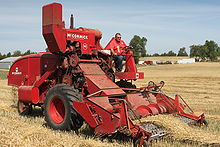 IH McCormick 141 Combine ca. 1954-57
IH McCormick 141 Combine ca. 1954-57
For some time, combine harvesters used the conventional design, which used a rotating cylinder at the front-end which knocked the seeds out of the heads, and then used the rest of the machine to separate the straw from the chaff, and the chaff from the grain. The TR70 from Sperry-New Holland was brought out in 1975 as the first rotary combine. Other manufacturers soon followed, IH with their 'Axial Flow' in 1977 and Gleaner with their N6 in 1979.
In the decades before the widespread adoption of the rotary combine in the late seventies, several inventors had pioneered designs which relied more on centrifugal force for grain separation and less on gravity alone. By the early eighties, most major manufacturers had settled on a "walkerless" design with much larger threshing cylinders to do most of the work. Advantages were faster grain harvesting and gentler treatment of fragile seeds, which were often cracked by the faster rotational speeds of conventional combine threshing cylinders.
It was the disadvantages of the rotary combine (increased power requirements and over-pulverization of the straw by-product) which prompted a resurgence of conventional combines in the late nineties. Perhaps overlooked but nonetheless true, when the large engines that powered the rotary machines were employed in conventional machines, the two types of machines delivered similar production capacities. Also, research was beginning to show that incorporating above-ground crop residue (straw) into the soil is less useful for rebuilding soil fertility than previously believed. This meant that working pulverized straw into the soil became more of a hindrance than a benefit. An increase in feedlot beef production also created a higher demand for straw as fodder. Conventional combines, which use straw walkers, preserve the quality of straw and allow it to be baled and removed from the field.
Combine fires
Grain combine fires are responsible for millions of dollars of loss each year. Fires usually start near the engine where dust and dry crop debris accumulate.[17] From 1984 to 2000, 695 major grain combine fires were reported to local fire departments.[18] Dragging chains to reduce static electricity was one method of preventing harvester fires.
See also
- Agricultural machinery
- Combine Demolition Derby
- Custom harvesting
- Museum of Scottish Country Life Largest collection of Combine Harvesters in Europe.
References
- Bibliography
- Quick, Graeme R.; Wesley F. Buchele (1978). The Grain Harvesters. St. Joseph: American Society of Agricultural Engineers. ISBN 0-916150-13-5.
- Notes
- ^ "About Combine harvesters". Mascus UK. http://www.mascus.co.uk/Agriculture/Used-Agricultural-Combine-harvesters.
- ^ Biographical Dictionary of the History of Technology. Taylor & Francis. http://books.google.com/books?id=n--ivouMng8C&pg=PA865&dq=Hiram+Moore+and+combine+harvester#v=onepage&q&f=false.
- ^ "The History of Combine Harvesters". Cornways. http://www.cornways.de/hi_combine.html.
- ^ Timesonline.co.uk, access date 31-09-2009
- ^ Historylink.com, access date 18-08-2009
- ^ The John Deere Tractor Legacy, Don McMillan, Voyageur Press, 2003, page 118 with photo
- ^ Remarkable Australian Farm Machines, Graeme R. Quick, Rosenberg Publishing, 2007, page 72.
- ^ Gleaner: 85 Years of Harvest History, Gleaner Agco Company, 2008, page 8
- ^ La maquinaria que haría historia, La Nacion, 6 Nov 2004 (Spanish)
- ^ "Carroll, Thomas (Tom) (1888 - 1968)", Australian Dictionary of Biography
- ^ CARROL J.: The World Encyclopedia of Tractors & Farm Machinery, 1999 Annes Piblisching Ltd, p. 127
- ^ Timesonline.co.uk, access date 31-09-2009
- ^ Farmindustrynews.com
- ^ Ag Power Mag, Sept 2001
- ^ Rahco.com, 2005
- ^ TheFactorycompany.com, 2007
- ^ UMN.edu
- ^ UMN.edu
External links
- "Gold Harvest Feeds The World" page 90 Popular Mechanics, July 1949, cutaway illustration of the John Deere open cab one-man self-propelled combine of the type common for decades after World War Two
- Pictures of combines with corn and wheat heads
- History of Sunshine Harvesters - Museum Victoria, Australia
- The Birth of the Australian Stripping Combine Harvester
- Pictures of Gleaner levelling combines
- The Combine Talk Forums - A Website with more information and pictures
Categories:- Agricultural machinery
- Combine harvesters
Wikimedia Foundation. 2010.

